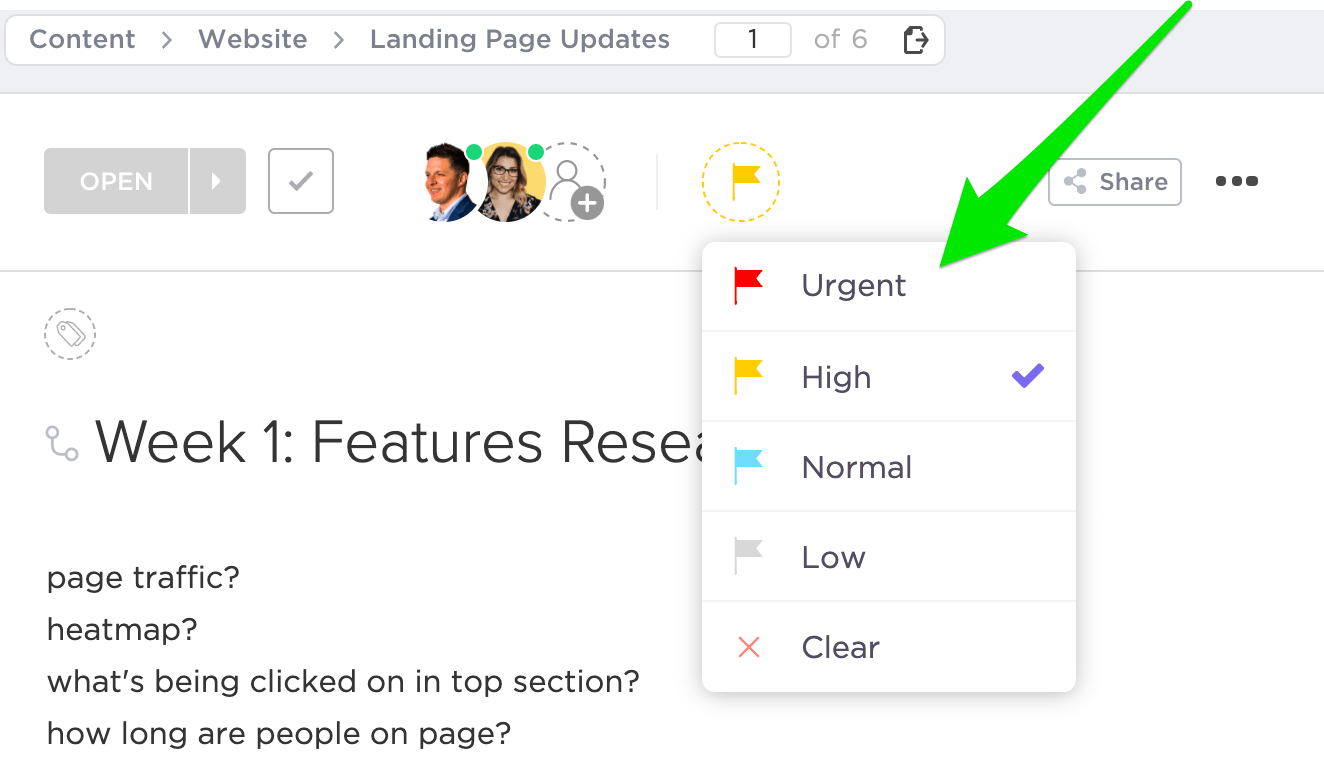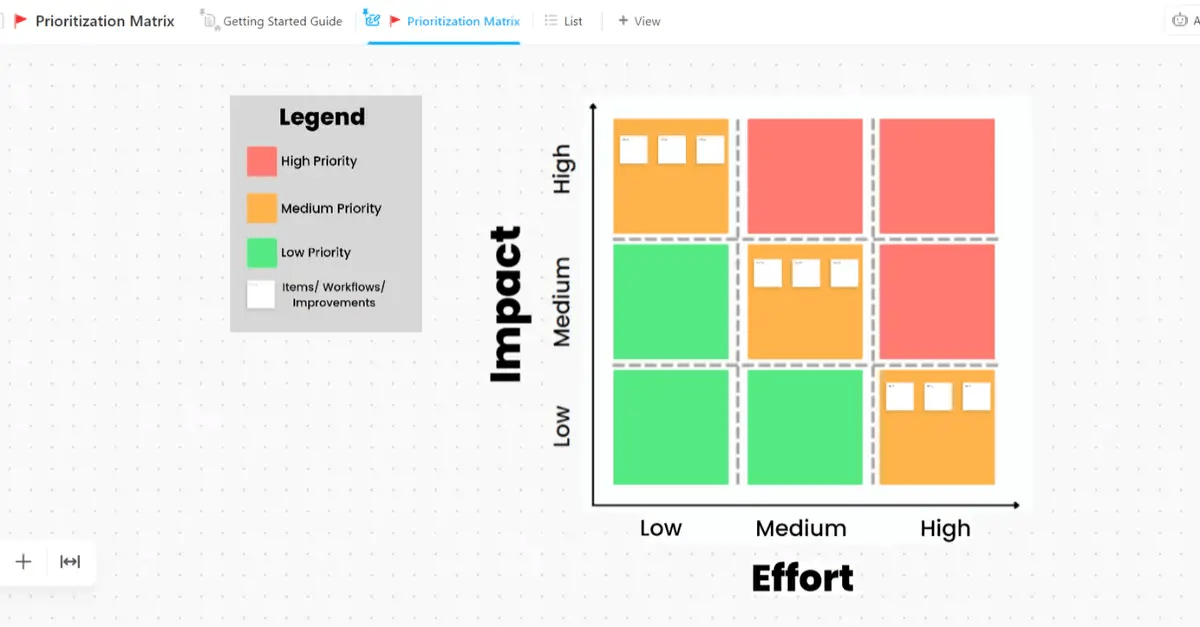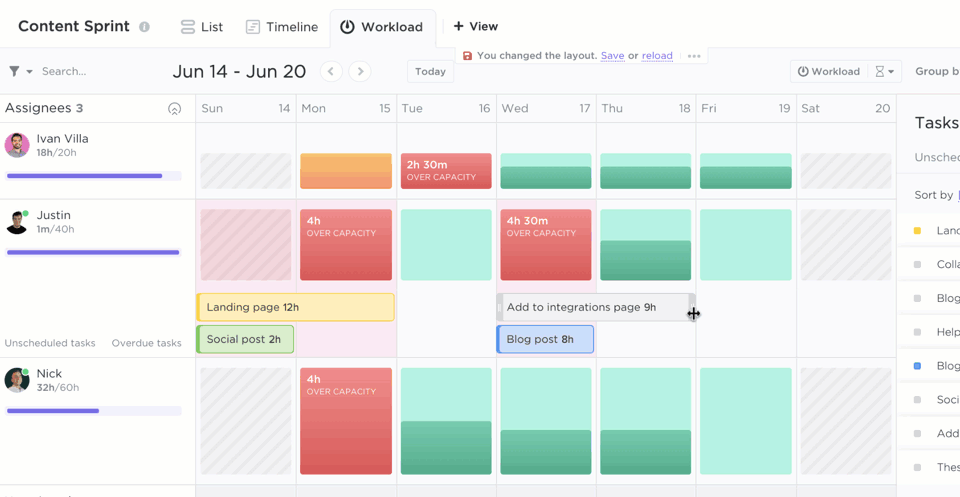How to Strategically Prioritize Projects (Free Template Included)

Sorry, there were no results found for “”
Sorry, there were no results found for “”
Sorry, there were no results found for “”

There’s no doubt about it… project time management is hard which means that most teams end up wasting hours on projects that don’t matter.
However, the real culprit isn’t poor execution. It’s saying yes to everything without a clear system for deciding what actually deserves your team’s attention.
When project requests come from every direction and nobody’s filtering for value, you end up spinning wheels on work that goes nowhere.
Smart project prioritization changes that. Here’s how to build a system that protects your team’s time and energy.
Project prioritization is deciding which work matters most when time and resources are limited. Teams evaluate projects based on strategic goals, expected benefits, costs, and risks, then rank them to see what deserves attention first.
The powerful thing about this concept is that ranking forces tough choices. Comparing projects side by side reveals conflicts and tradeoffs that weren’t obvious before.
Some projects get the green light, others get shelved because they don’t align with where the company actually needs to go.
A solid ranking system removes the guesswork by giving teams clarity on what they’re working toward, why it matters, and how to measure progress.
Instead of spreading resources thin across every request that lands on the desk, teams can focus on work that actually moves the business forward.

Poor prioritization often stems from managing multiple projects at once which creates a cascade of problems that compound over time:
The financial toll is significant as well, with organizations wasting 9.9% of every dollar invested due to poor project performance. This means teams miss market windows and watch budgets drain into projects that never should have started.
Effective prioritization creates a shared understanding of what success looks like, which gives teams the clarity to make faster decisions and execute with confidence instead of constantly second-guessing their next move.
Before diving into frameworks, recognize whether your team actually needs better prioritization by watching for a pattern that starts small and spirals.
Everything begins feeling urgent, which pushes teams into constant firefighting mode where they never make steady progress on planned work. This chaos typically reveals an underlying imbalance.
When this happens, the best best performers are drowning in requests while others sit with open capacity, mainly because work flows to whoever seems safest rather than who has bandwidth or needs the development opportunity.
The situation compounds when stakeholders notice the process isn’t working and start bypassing it entirely with “quick requests”.
These oftentimes sound reasonable in isolation but collectively fragment attention and destroy any momentum on strategic projects.
Eventually, teams find themselves pushing the same initiatives to the next sprint over and over without understanding why. This signals they’re missing the shared criteria needed to distinguish what deserves attention now from what can wait.
If this progression sounds familiar, a structured approach will fix it by creating clear criteria, protecting capacity, and aligning work to measurable business value.
Building an effective prioritization system requires a complete process where each step reinforces the others.
Start by filtering what reaches your team, then move through ranking, alignment, organization, and delegation to create something that actually works in practice.
The first defense against overwhelm happens before prioritization begins.
When requests flow through email, Slack, meetings, and hallways, teams waste time hunting for details, sorting duplicates, and getting pulled into half-formed ideas.
ClickUp Forms create a single entry point where requestors must provide essential information before their project reaches the team.
The intake form asks questions that force strategic thinking:
A marketing request that can’t articulate success metrics or strategic goals isn’t ready for team involvement, and the form makes this clear before anyone wastes time in discovery meetings.
Share the link widely so team members can redirect ad hoc requests with “Submit that through our intake form so we can evaluate it properly” rather than derailing current work.
We’ve successfully implemented a form-based ticketing system within the engineering team at ClickUp, which has drastically reduced the teams’ fires and helped them reclaim some of their productive time.
After filtering incomplete requests, rank remaining projects by plotting them on two axes where vertical represents impact and horizontal shows effort.
This creates four quadrants that reveal what to do with each project.
High-impact, low-effort work becomes quick wins to tackle immediately, while high-impact, high-effort projects become strategic initiatives needing careful planning.
Low-impact work of any effort level gets deprioritized or eliminated because these projects drain resources from work that actually moves business metrics.
ClickUp’s Prioritization Matrix Template provides a whiteboard where teams drag projects between quadrants as circumstances evolve.
The visual format immediately reveals dangerous patterns, like six high-effort projects competing for three senior developers, or quick wins fragmenting attention from strategic work needing sustained focus.

Revisit the matrix regularly as circumstances evolve.
That infrastructure project eating up engineering capacity might suddenly become much simpler after you complete a related platform upgrade, which shifts where it sits relative to other work and could justify accelerating it.
Making it through intake and landing in a favorable quadrant doesn’t guarantee execution.
The harder filter asks whether the work connects to measurable business value through concrete ROI, strategic alignment, or meaningful operational impact.
Projects that fix production issues preventing customer use, address retention threats backed by churn data, or unlock proven revenue streams naturally rise to the top.
On the other hand, work that seems interesting but doesn’t tie to strategic objectives gets shelved regardless of who champions it.
The difficult part is communicating these decisions to stakeholders who expected different outcomes. But clear reasoning makes it manageable:
These conversations get easier over time.
Applying the same criteria consistently rather than making ad hoc decisions based on who asks most persistently builds credibility that makes future prioritization discussions more straightforward.
After knowing which projects to pursue, organize work into sprints that batch related projects together. This reduces context switching and builds momentum that accelerates delivery.
Take designers, for example, who might tackle three brand refreshes in one sprint.
They’ll stay in the same mental space to build reusable components and develop rhythm that makes the third project faster than the first.
Similarly, when developers cluster infrastructure updates, they address dependencies efficiently and avoid startup costs of switching technical contexts.
Both use sprints, a fixed period for completing specific work.

Software teams typically use two-week cycles, while marketing teams might run month-long sprints aligned to campaigns and design teams use three-week sprints accommodating both quick turnarounds and multi-review projects.
During each sprint, teams break projects into tasks, assign based on capacity, then review progress before planning the next cycle. This creates natural checkpoints for evaluating whether priorities still hold.
Task batching also protects time for maintenance work like clearing technical debt or refreshing evergreen assets without letting it interrupt strategic projects needing sustained focus.
Tip: Check out the most common productivity systems to get more done with less.
Great prioritization fails if you consistently overload the wrong people.
When one person becomes the default for every important project because they deliver reliably, you’ve created a bottleneck that will eventually break.
This creates three problems: burnout risk for valuable contributors, limited growth from doing the same work repeatedly, and preventing others from developing skills to share the load.
Watch for warning signs before burnout:
When redistributing work, explain reasoning so it doesn’t feel like punishment:
“I’m reassigning the homepage refresh to Jordan so you can focus on the portal redesign, which needs your experience and pushes your growth better than another batch of marketing pages.”
Mid-level members need exposure to challenging work to develop judgment and skills. Keeping them on low-risk routine work creates a skill gap forcing continued overreliance on senior contributors.
I suggest checking out ClickUp’s Workload view, which shows each member’s committed capacity in visual format.
Instead of intuition about who seems busy, you work from data about who has bandwidth and who’s approaching overload.

Even solid systems fail when teams fall into predictable traps.
Treating everything as urgent destroys priority. Define concrete criteria for what “urgent” means, whether impacting revenue today, blocking other teams, or creating customer-facing failures.
Skipping review cycles allows priorities to drift from reality. Market conditions shift, blockers appear, needs evolve. Weekly or biweekly reviews catch these changes before they derail planned work.
Letting the loudest voice win replaces strategy with politics. Stick to your framework even when disappointing vocal stakeholders, because consistency builds credibility.
Ignoring team capacity when accepting work guarantees distributed failure. Taking on more than realistic creates thrash where people spread thin deliver low-quality work late.
Forgetting to communicate decisions leaves people filling gaps with assumptions. When stakeholders don’t understand deferrals or team members don’t know task purpose, they can’t make informed decisions about tradeoffs.
These five steps work together, but the system requires ongoing maintenance to stay effective.
Start with weekly 15-minute check-ins to confirm your top priorities haven’t shifted based on new information.
These feed naturally into monthly reviews where you examine all active projects and kill anything that’s stalled or drifted from strategy.
Every quarter, step back further to refresh your strategic goals and realign the entire project pipeline based on what changed or what you learned.
Keep a parking lot document for work you’ve declined so these ideas don’t get lost or keep resurfacing in new requests. Track concrete metrics like completion rates and stakeholder satisfaction to measure whether the system actually works instead of relying on gut feelings.
The process gets easier over time as your team develops shared understanding of what matters, sharper judgment about tradeoffs, and real confidence in saying no to work that doesn’t serve your goals.
Try ClickUp and experience the positive changes it can make for your team’s productivity.
Our platform gives you the tools to structure your ideal project prioritization process. In just a few clicks, you can start with the big picture and zoom into the details of any task.
Create a free ClickUp account today and stay energized with the work you have ahead. If you need any support, please reach out to us through the Help Center or catch any of our on-demand webinars.
Happy planning!
© 2025 ClickUp